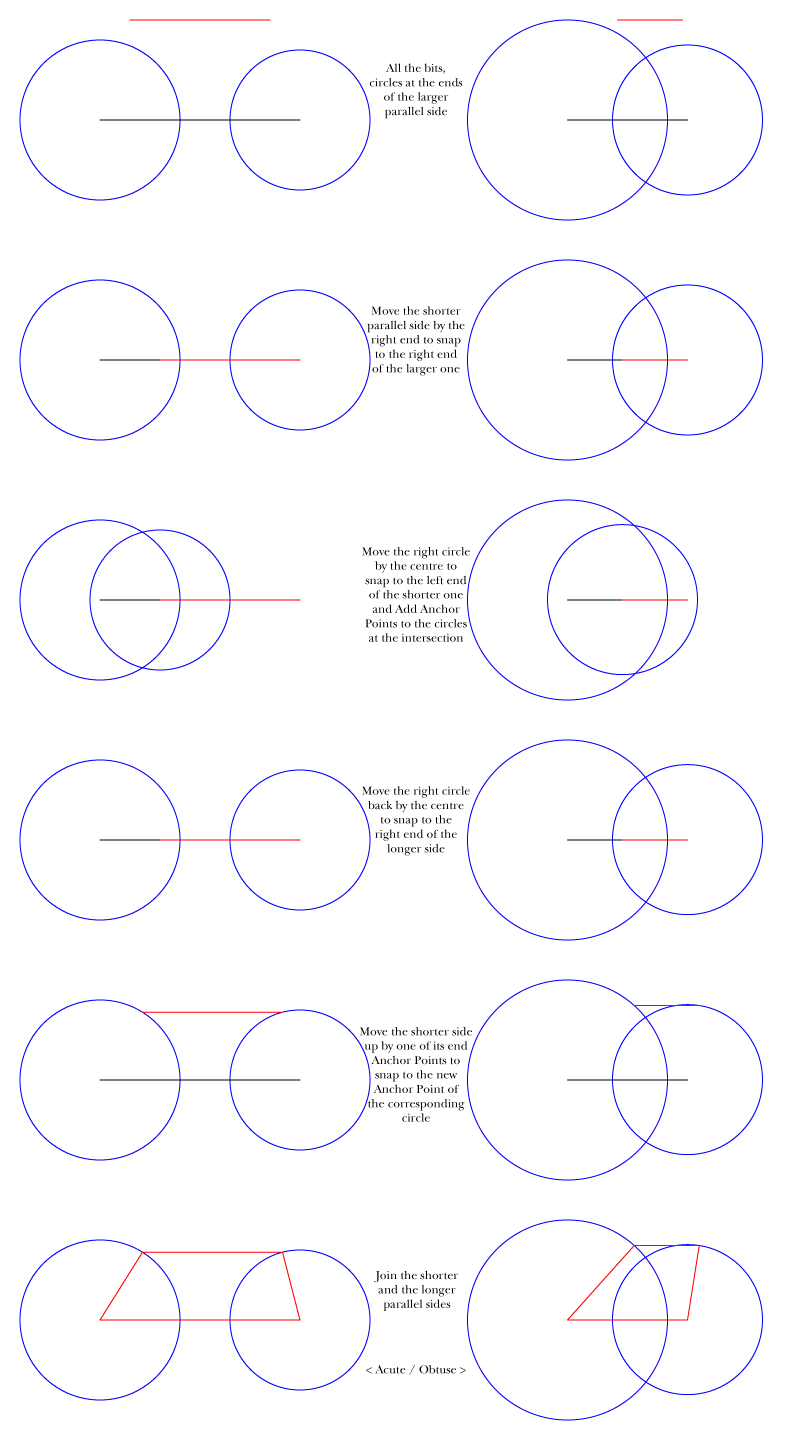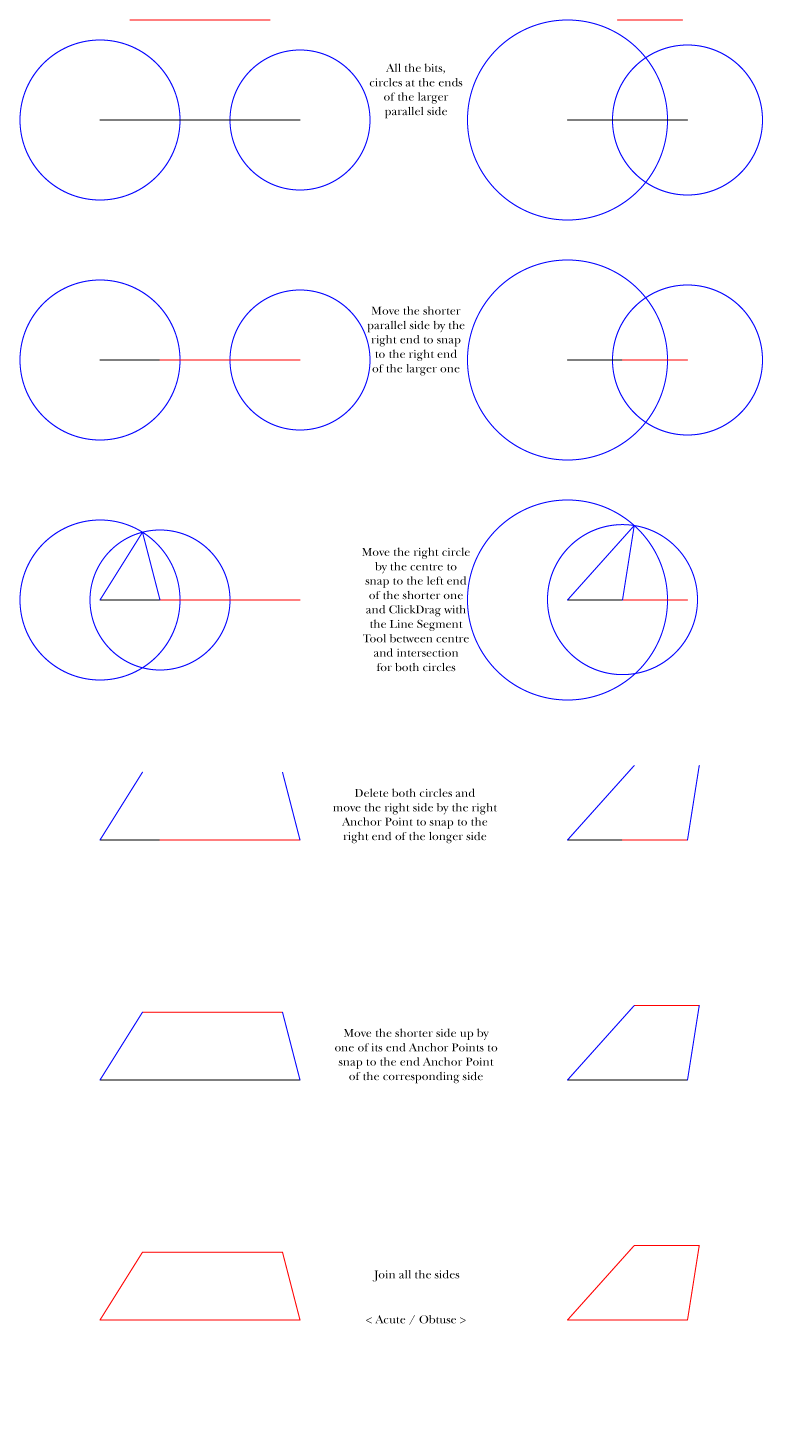- Home
- Illustrator
- Discussions
- Re: How to draw irregular trapezoids with precise ...
- Re: How to draw irregular trapezoids with precise ...
Copy link to clipboard
Copied
So this is not a case of drag and drop the edges because I`m trying to make the forms with specific measurements. Anyone has had success with this?
Thanks!
 1 Correct answer
1 Correct answer
clabtl,
Here is a way to do it, and some more old stuff, from a thread 11 years ago, the parallel sides being L1 and L2 and the non parallel ones being R1 and R2.
You can calculate D1 and create a horizontal line of that length from the left of L1, then just create a vertical line past the R21 circle, then create a horizontal line with the length L2 and snap it to the intersection, and the other end will touch the R2 circle, and then you can join L1 and L2. No need to calculate H.
Or, Smart Guides
...Explore related tutorials & articles
Copy link to clipboard
Copied
I haven't worked it out yet using native Illustrator tools. I can do it with Astute Graphics's ColliderScribe plugin, if that's of any interest to you.
Peter
Copy link to clipboard
Copied
clabt,
Assuming you can create it with horizontal opposite sides of known specific lengths (widths) and a known specific distance between them (height), you may, Smart Guides being your friends:
1) Create an outer and an inner rectangle and place them on top of each other,
2) Move either horizontally to obtain the desired frame for the trapezoid/trapezium,
3) Copy either to the top, then deselect and with the Direct Selection Tool ClickDrag each of the two relevant Anchor Points to snap to the corresponding Anchor Point of the other rectangle.
I believe you can work in similar ways for other ways of defining/determining/deciding the size and shape.
Edit: Hi Peter.
Copy link to clipboard
Copied
Great answer, JET. I don't have the height but using triangles might help. Thank you.
Copy link to clipboard
Copied
Which version of Illustrator are you using?
Copy link to clipboard
Copied
Just updated to CC 2019
Copy link to clipboard
Copied
…I`m trying to make the forms with specific measurements.
Clabtl,
Provide an example of one that you cannot draw "with specific measurements." A good answer requires knowing what your requirements are, and what kind of measurements you have.
JET
Copy link to clipboard
Copied
I have a sketch with three trapezoid shapes with measurements for their sides. Two sides in each of these trapezoids are parallel and the other two sides seem to be bent in very different inclinations. All three trapezoid have different measurements (close, but enough to make a visual difference, and the angles of some of their sides seem to differ a great deal.
Copy link to clipboard
Copied
clabtl,
Here is a way to do it, and some more old stuff, from a thread 11 years ago, the parallel sides being L1 and L2 and the non parallel ones being R1 and R2.
You can calculate D1 and create a horizontal line of that length from the left of L1, then just create a vertical line past the R21 circle, then create a horizontal line with the length L2 and snap it to the intersection, and the other end will touch the R2 circle, and then you can join L1 and L2. No need to calculate H.
Or, Smart Guides being your friends, maybe with less than full accuracy, or maybe with a lot of trying and zooming, you can create L1, R1, and R2, as shown, then create L2 and move (ClickDrag) it by one end Anchor Point along the corresponding circle until you are satisfied with the fit to the other circle, you can go back and forth between the end Anchor Points and see whether you have an intersection or not. The greatest/easiest accuracy is obtained if you move along the largest circle.
Copy link to clipboard
Copied
Some good ol' basic geometry, perfect. Will give it a try. Thank you!
Copy link to clipboard
Copied
You are welcome, clabtl.
Copy link to clipboard
Copied
Copy link to clipboard
Copied
That's perfect, even easier. Thank you again.
Copy link to clipboard
Copied
You are welcome, clabtl,
I quite like the explanatory way with its keeping the circles till the end, but below is an even simpler way, Smart Guides are still your friends.
You may say that Illy sometimes moves in mysterious ways, but she is always eager to help, and as often said there is always more than one way.
Copy link to clipboard
Copied
If you at least know the lengths of the two parallel sides, drawn as individual lines you could then measure the exact distance apart you spread them out. This will give you your varied width and height. Then use the Join feature on the two left side and then the two right side anchor points.
If you are going to need to be specific with the angles of the non-parallel sides, draw those as two individual lines with them. You can draw them vertically constraining with shift, then use the rotate feature to set the angle. Then align as needed, space apart by the distance you need, and then join anchor points.
Find more inspiration, events, and resources on the new Adobe Community
Explore Now



